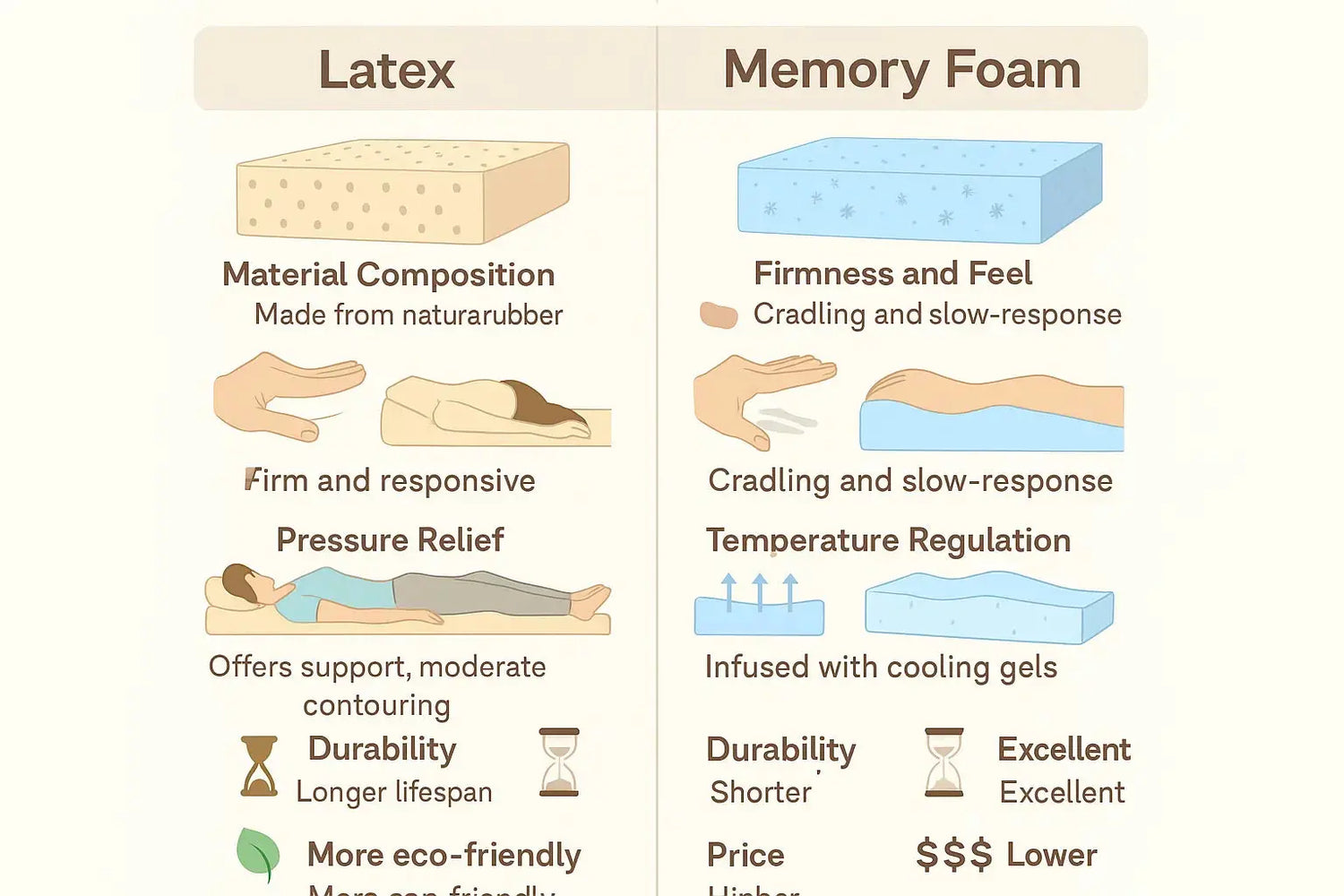
Choosing the right mattress material can be a game-changer for your sleep quality. Two popular options that often come up in mattress shopping are latex and memory foam. Both materials offer unique benefits, but understanding their differences will help you decide which one suits your sleeping preferences better. Here’s a detailed comparison to help you make an informed decision.
1. Material Composition
- Latex: Made from natural rubber, latex mattresses are designed to provide a resilient, bouncy feel. They are available in both natural (derived from rubber trees) and synthetic (made from petrochemicals) forms. Natural latex tends to be more eco-friendly and durable than synthetic latex.
- Memory Foam: Memory foam is made from polyurethane and is often infused with other materials like gel or plant-based oils to improve its feel and cooling properties. It’s known for its ability to conform to the body and relieve pressure points.

2. Firmness and Feel
- Latex: Latex provides a firmer, more responsive feel compared to memory foam. It bounces back quickly when you move, making it easier to change positions during the night. It's ideal for those who prefer a more supportive and "floating on top" feel rather than sinking deeply into the mattress.
- Memory Foam: Memory foam has a slower response time, which allows it to mold closely to the shape of your body. This creates a cradling effect that helps relieve pressure points. However, some people find the "sinking" sensation of memory foam uncomfortable, especially those who prefer a more buoyant feel.
3. Pressure Relief
- Latex: While latex offers support, it may not provide the same level of contouring as memory foam. However, its responsiveness allows for pressure relief by evenly distributing body weight. It's particularly beneficial for individuals who need a firmer mattress but still want some cushioning.
- Memory Foam: Memory foam excels in pressure relief. It conforms to your body’s shape, providing targeted support for areas like the hips, shoulders, and lower back. This makes memory foam a great choice for individuals with joint pain or pressure-sensitive areas.
4. Temperature Regulation
- Latex: Latex mattresses are naturally more breathable due to their open-cell structure and ventilation holes. This helps with airflow and temperature regulation, making latex a better choice for those who tend to sleep hot.
- Memory Foam: Memory foam can trap heat, as it is more dense and has a tendency to hug the body closely. However, many modern memory foam mattresses are infused with cooling gels or have a cooling cover to help mitigate heat retention. Even with these enhancements, memory foam mattresses generally don’t perform as well as latex when it comes to keeping cool.
5. Durability
- Latex: Latex mattresses are incredibly durable and can last 10-20 years or more if properly maintained. Natural latex, in particular, has excellent resilience, maintaining its shape and performance over time.
- Memory Foam: Memory foam mattresses generally last around 7-10 years, depending on the quality of the foam. While high-density memory foam can be durable, it may show signs of wear and tear, such as sagging, after several years of use.
6. Motion Isolation
- Latex: Latex provides moderate motion isolation. While it reduces motion transfer better than traditional innerspring mattresses, it doesn’t perform as well as memory foam. The responsiveness of latex can sometimes allow more movement to transfer across the bed.
- Memory Foam: Memory foam excels at motion isolation. Since the material conforms to the body and absorbs movements, it significantly reduces the transfer of motion. This makes it an excellent choice for couples, especially if one person moves around a lot during sleep.
7. Eco-Friendliness
- Latex: Natural latex is a more eco-friendly option, as it is made from renewable resources (rubber trees). It is biodegradable and does not off-gas harmful chemicals. However, synthetic latex, which is derived from petrochemicals, is not as environmentally friendly.
- Memory Foam: Traditional memory foam is made from petrochemicals, making it less environmentally friendly. However, many memory foam manufacturers are now offering more sustainable options, such as plant-based foams, which reduce the ecological footprint.
8. Price
- Latex: Latex mattresses, particularly those made from natural latex, tend to be more expensive. However, the durability and long lifespan of latex mattresses can make them a worthwhile investment.
- Memory Foam: Memory foam mattresses are generally more affordable than latex mattresses, though prices can vary depending on the density and quality of the foam. High-quality memory foam mattresses with cooling technologies or organic materials can cost more.
9. Ideal For
- Latex: Latex is ideal for those who prefer a firm, responsive feel with moderate pressure relief. It's great for people who sleep hot, are looking for a more eco-friendly option, or need a long-lasting mattress.
- Memory Foam: Memory foam is perfect for individuals who need deep pressure relief, suffer from joint pain, or sleep with a partner and need excellent motion isolation. It's also ideal for those who don’t mind a softer feel and prefer a mattress that contours to their body.
| Feature | Latex | Memory Foam |
| Material | Made from natural rubber or synthetic rubber. | Made from polyurethane foam, often with added gels or oils. |
| Feel | Firm, responsive, bouncy, and supportive. | Soft, contouring, and cradling. |
| Pressure Relief | Provides moderate pressure relief. | Excellent pressure relief, particularly for joints. |
| Temperature Regulation | Naturally breathable, cooler to sleep on. | Can trap heat, but many models have cooling features. |
| Durability | Highly durable, can last 10-20 years. | Typically lasts 7-10 years, can show sagging with age. |
| Motion Isolation | Moderate motion isolation. | Superior motion isolation, ideal for couples. |
| Eco-Friendliness | Natural latex is eco-friendly. | Traditional foam is less eco-friendly, but plant-based options are available. |
| Price | Generally more expensive. | More affordable, though high-quality models can be costly. |
| Best For | Those who need support, sleep hot, or prefer a more eco-friendly option. | Those needing deep pressure relief, motion isolation, and a softer feel. |
Why Choose Anmiz?
Anmiz mattresses offer innovative features designed for optimal comfort, support, and durability. With cutting-edge technologies like Anmiz-Y™ for enhanced breathability and pressure relief, MotionGuard™ for motion isolation, and Luna-Lumbar Zone™ for targeted back support, Anmiz mattresses are built to improve your sleep quality. Whether you're looking for a firm mattress to support your back or a softer feel to relieve pressure points, Anmiz offers a range of mattresses that cater to various sleep preferences. Designed with both comfort and longevity in mind, Anmiz ensures that you get the best night's sleep—night after night.
Conclusion
Choosing between latex and memory foam depends on your personal preferences and sleep needs. If you prioritize cooling, durability, and a firmer, more responsive feel, latex may be the better choice. On the other hand, if you need deep pressure relief, motion isolation, and a softer, body-contouring feel, memory foam might be your ideal option.
Ultimately, both materials offer unique benefits, so it's important to consider factors like sleep position, body type, temperature preferences, and durability when making your decision.







